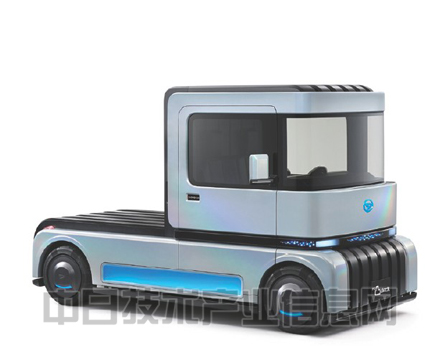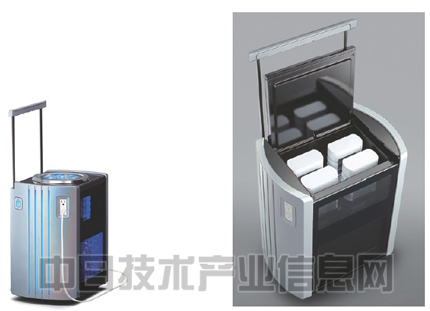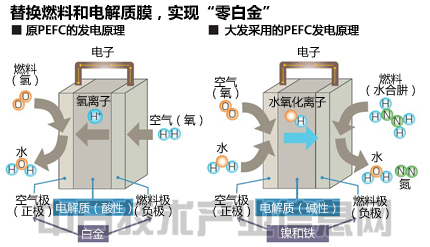"We hope to introduce a fuel cell vehicle with Daihatsu's characteristics of light-duty vehicles," said Tanaka Yuji, an administrative technical expert at Daihatsu Industrial Development. In November 2013, the company unveiled a prototype car equipped with a fuel cell at the Tokyo Motor Show. It is characterized by “no precious metals†– its platinum usage is zero. Conversion ideas, do not use platinum The fuel cell uses a chemical reaction of hydrogen and oxygen to generate electricity without emitting carbon dioxide. In order to realize a low-carbon society in the future, fuel cells are expected as a power source for automobiles and a distributed power source for powering homes and offices. Fuel cell vehicles and fuel cell systems in Daihatsu Industries. Reduce costs without using precious metals "FC convex DECK" exhibited at the 2013 Tokyo Motor Show. A fuel cell system is installed under the seat The fuel cell system "FCDock" (left) used as a transportable generator was exhibited at the Tokyo Motor Show. Fill the fuel bottle with hydrazine hydrate and install it on the system (right) To be popularized, further cost reductions are needed. Fuel cell vehicles will begin to be commercially available in 2015. About 10 years ago, the price of a fuel cell vehicle was as high as 100 million yen. Now, in order to lower the price to less than 10 million yen, various manufacturers have started technical competition. The main reason for the high cost of fuel cells lies in the rare metals used in the main components. The vehicle "Solid Polymer Fuel Cell (PEFC)" uses 30g of platinum per vehicle. Daihatsu’s fuel cell does not use platinum at all. To facilitate the reader's understanding of the reasons for this, first introduce the structure of the hydrogen fuel cell. The parts that hydrogen fuel cells use to generate electricity are called “batteriesâ€: hundreds of “units†made of sheet metal are arranged. The unit has two electrodes, an "air electrode" and a "fuel electrode", with an "electrolyte membrane" interposed therebetween. When hydrogen contacts the fuel electrode coated platinum catalyst, the electrons separate out as hydrogen ions. Hydrogen ions are squeezed through the electrolyte membrane that only allows ions to pass to the air pole. The electrons cannot pass through the membrane, so they are sent to the air pole through wires. The oxygen on the air electrode reacts with the hydrogen ions and electrons that are sent to form water. When an electron is transmitted by a wire, an electric current is generated to take out the energy. Tanaka explained the reason for the use of platinum in the previous fuel cell catalysts. "The electrolyte membrane is made of a strongly acidic material. The material that is resistant to corrosion in an acidic environment is a precious metal. Among them, platinum is particularly efficient at cutting off the bond between hydrogen ions and electrons. ". Dafa’s thinking has changed dramatically at this point. First, the electrolyte membrane is replaced with an alkaline material, and alkali does not easily corrode the metal. Hydrogen was also dispensed with, and the compound "hydrogen hydrazine" of hydrogen and nitrogen was selected. The fuel electrode is made of nickel and the air is made of iron. Tanaka said, "The combination of new fuel and low-cost catalyst can cut the bond between ions and electrons more efficiently than platinum." While replacing the electrolyte membrane with alkali, a mechanism is employed in which water ions are not moved in the unit but are moved from oxygen and water. The goal is to circulate in existing infrastructure. Other advantages of hydrazine hydrate are the availability of existing distribution infrastructure. Hydrazine hydrate is a liquid at normal temperature, and at the high concentration, it is the "third petroleum class" in "Class 4 dangerous goods" prescribed by the Fire Protection Law in Japan. Compared with the first petroleum-based gasoline and the second petroleum-based kerosene and diesel oil, the flammability is lower. In fact, when hydrazine hydrate is used as a fuel for a fuel cell vehicle, the concentration is low and the safety is high. But the government needs to allow and relax the regulations. Tanaka’s fancy is that “Hydration Hydrazine is a liquid, so it can make use of existing gas station equipment and technical experience. It is convenient to useâ€. If it is a fuel cell in the past, the construction of a hydrogen circulation infrastructure becomes a bottleneck. Since it was first fully circulated as a commercial fuel in Japan, almost all equipment requires new investment. Moreover, due to the high flammability of hydrogen, it is also necessary to ensure safety. Hydrazine hydrates, including the development of relevant regulations, can reduce infrastructure investment costs if they can be circulated. When hydrogen is used as a fuel, it is also necessary to use a high pressure compression and a fuel tank for safely transporting hydrogen. In order to reduce the weight while ensuring strength, it is necessary to use a large amount of expensive carbon fiber, and the proportion of the overall cost of the fuel cell vehicle is also high. The hydrazine hydrate can be used in a plastic container. The use of hydrazine hydrate also improves power generation performance. Because of the heat loss compared to previous fuel cells. The "theoretical electromotive force rate" of hydrazine hydrate that converts energy into electricity is about 1.3 times that of hydrogen. If it can generate electricity efficiently, the number of units can be reduced by 30% compared with the previous fuel cells. However, Tanaka also said frankly that "the power generation efficiency has not been fully improved yet." As one of the countermeasures, Tanaka cited the method of "adjusting the material of the electrolyte membrane so that it can efficiently pass ions generated by water oxidation". In a fuel cell, a "potential" difference occurs between the air electrode and the fuel electrode, and the electrons move accordingly to generate an electric current. However, there is now a phenomenon in which fuel oozes out of the membrane, resulting in a decrease in potential difference, which is a cause of insufficient power generation efficiency. In addition, we will improve the catalysts and solve the existing problems. "We hope that the productization time will not be later than other companies that started to market in 2015." Tanaka is eager to try. Platform Trolley,Folding Platform Hand Truck,Platform Push Cart,Stainless Steel Platform Trolley Dalian CS Logistics Technology Co., Ltd , https://www.dlcslogistics.com

